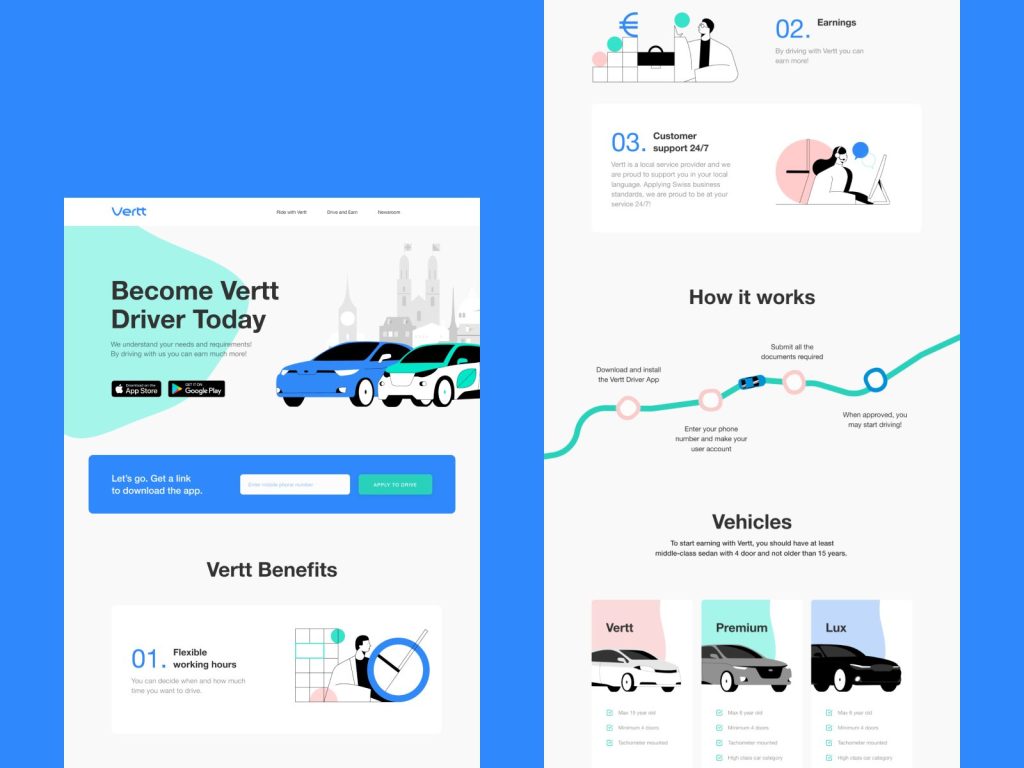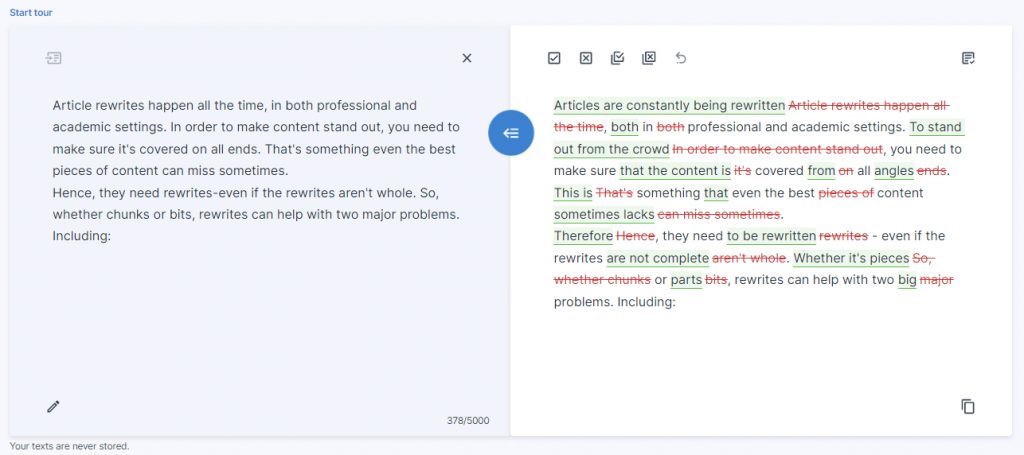The content on your website plays a pivotal role in converting visitors into customers and establishing a robust online presence. According to optinmonster.com, for over 34% of bloggers, updating content is the key to yielding substantial results. Rewriting your website content goes beyond mere refinement; it can markedly improve the user experience, drive increased traffic, and elevate your search engine rankings.
Now, let’s delve into the significance of rewriting your website content. Additionally, we’ll explore valuable tips and effective strategies to rewrite website content that resonates with your target audience.
The article will not mention “Web rewrite the sentences” or “Article rewriter tool” because this is an article aim to provide you with content strategy & How to Rewrite Website Content for Enhanced Visibility.
Why rewriting your website content is significant?
Your business’s online presence is embodied by your website, serving as the forefront of your brand. This digital space is a platform to display your products or services, frequently marking the initial interaction with potential customers.
Consequently, ensuring that your website authenticates your brand is imperative. The goal is to deliver substantial value to your users, and one effective approach is to consistently update, refine, and invigorate your website content.
The importance of rewriting your website content stems from various crucial reasons:
Establishing Trust and Credibility
Producing high-quality content that addresses your audience’s needs and offers solutions contributes to building trust and credibility. When your audience perceives your content as informative and valuable, it positions you as an authority in your industry, fostering trust in your brand.
Stay Current with Trends and Changes
Staying abreast of trends and adapting to changes is crucial in the ever-evolving digital landscape. Regularly rewriting website content allows you to update your platform to align with shifts in industry dynamics, evolving audience preferences, and modifications in search engine algorithms.
Enhance User Experience
Website visitors anticipate content that is not only of high quality but also easy to comprehend, engaging, and directly relevant to their requirements. The act of rewriting website content is instrumental in enhancing the overall user experience by ensuring that the material is more readable, understandable, and actionable.
Elevate Search Engine Rankings
Search engines, such as Google, reward websites featuring high-quality, pertinent, and up-to-date content with higher rankings in search results. By strategically rewriting website content and incorporating targeted keywords, you can enhance your website’s search engine rankings and visibility and subsequently attract more traffic and conversions.
Communicate a Clear Message:
Effective marketing hinges on clear communication; your website content is the primary conduit for conveying your brand message to your target audience. Regularly rewriting website content ensures your message remains clear, concise, and compelling, fostering increased engagement and conversions.
Drive Engagement and Conversions:
Compelling, high-quality content that resonates with your audience is a catalyst for driving engagement and conversions. When your audience finds your content valuable, they are more inclined to share it, expanding your reach. Moreover, quality content can influence potential customers to take action, be it purchasing or subscribing to a newsletter.
Build Brand Awareness and Loyalty:
Quality content aligned with your brand values and messaging significantly builds brand awareness and loyalty. Such content differentiates your brand from competitors and establishes a loyal following among your audience.
Establish Thought Leadership:
Thought-provoking content that provides insights and perspectives positions you as a thought leader in your industry. When your audience recognizes you as an expert, they are more likely to seek out your content actively, elevating your brand’s influence and following.

Rewrite content to make it unique: the limitation
By now, I trust that the significance of rewriting website content is apparent. However, it’s crucial to acknowledge this process’s limitations and potential risks: the unique content.
One notable risk is the potential compromise in content quality when engaging different writers for various rewriting needs on your website. Establishing an in-house team with writers trained according to your specifications is advisable to maintain consistency and adherence to your communication policies and marketing strategies.
The in-house approach also mitigates the risk of unintentional plagiarism if an external writer resorts to duplicating content from a competitor.
Additionally, when considering the limitations of rewriting website content, it’s essential to factor in the geographic location of your audience. Adapting content to align with their culture, mindset, and language, where applicable and feasible, is crucial for ensuring relevance and resonance.
How to Rewrite Website Content for Enhanced Visibility
Whether you are a seasoned content creator looking to optimize your site for search engines or a business owner aiming to improve online discoverability, this comprehensive exploration will provide you with invaluable insights and practical tips to elevate your website’s visibility
Know Your Target Audience
When crafting website content, a crucial aspect is comprehending your intended audience. A website that fails to directly address its target demographic is unlikely to succeed in retaining readers or converting visitors into customers. Therefore, understanding your target audience is a paramount step in the content writing process.
This entails developing profiles for various segments of your desired audience, encompassing age, gender, occupation, interests, and pain points. By doing so, you can tailor your content more effectively to meet your audience’s specific needs and interests.

Another critical aspect of audience understanding involves mapping their journey through your website. This includes delineating the various touchpoints users may encounter, from the initial click-through to the point of conversion. This comprehensive mapping allows you to pinpoint areas where your content may be losing readers or failing to engage them, enabling you to make necessary adjustments.
Ultimately, delving into the intricacies of your target audience empowers you to create content that resonates on a profound level. By comprehending their needs, interests, and pain points, you can craft personal and relevant messages. This personalized approach keeps readers engaged with your content and fosters trust and loyalty over time.
Discerning elements that necessitate rewriting
Initiating the process of rewriting your website content:
- Meticulous assess your current content: analyze existing pages and identify elements that warrant a rework.
- Include the age and relevance of your content, alignment with brand messaging, and responsiveness to the needs of your target audience.
- Answer the following questions before rewriting:
- Is your content up-to-date and reflective of your brand values?
- Does it clearly articulate your business offerings and differentiators?
- Are you effectively addressing your audience’s pain points and requirements?

Another critical aspect to scrutinize is your website’s structure and layout.
- Evaluate whether your content is easily navigable or buried within the depths of your website.
- Check for any instances of duplicate content or information scattered across multiple pages.
- Ensuring that your content is well-organized and accessible is pivotal for a positive user experience, and it can enhance your website’s search engine optimization (SEO).
With a comprehensive understanding garnered from the content assessment, you gain insights into what requires rewriting. Develop a detailed plan and timeline for the content rewriting process to maintain focus and ensure no vital pages are overlooked.
Optimize the Content for SEO
Integrating keywords and employing SEO tactics is pivotal when revamping website content. Research indicates that over 53% of website traffic originates from organic search, underscoring the importance of SEO in the content creation.

Incorporating Appropriate Keywords
By incorporating optimized keywords, a website has a better chance of securing high rankings on search engine results pages, facilitating easy content discovery by the target audience. An effective strategy is to leverage long-tail keywords—specific phrases or queries likely to be searched by the target audience.
Implementing Technical SEO
Beyond keyword selection, comprehending the technical aspects of SEO is equally crucial. This involves establishing an SEO-friendly URL structure, optimizing titles and descriptions, and incorporating internal links. Additionally, utilizing meta and alt tags for images enhances search engine visibility. These techniques ensure a broader audience encounters the content, fostering a more robust online presence.
Strategic Keyword Placement and Heading Usage
While integrating keywords is essential, it must be done judiciously. Excessive keyword stuffing results in irrelevant and subpar content. Striking a balance in keyword density and aligning keywords with the website’s purpose and audience needs is imperative. Furthermore, crafting compelling headlines and subheadings enhances readability and aids in conveying the main ideas effectively.
Considering the Audience
To optimize content for search engines, it’s crucial to factor in the needs and language of the target audience. Employing colloquial language that resonates with the audience and integrating local content enhances visibility, particularly for websites catering to specific geographical regions. Aligning the language and tone with the target audience’s preferences fosters trust and loyalty between the brand and its audience.
Final Steps
However, before it is published live, essential final steps must be undertaken to ensure its readiness for publication. These steps encompass meticulously proofreading the content and conducting thorough website testing.
Proofreading the Content
The act of proofreading holds immense importance in guaranteeing the quality of website content. This step is crucial for eliminating spelling and grammatical errors while ensuring a consistent tone and voice. Proofreading is integral to presenting a professional and credible appearance to visitors. A website with spelling mistakes or poor grammar may convey an untrustworthy impression.
A helpful tip during proofreading is introducing a break between writing and editing. This pause allows the writer to revisit the content with fresh eyes, catching any errors that might have been overlooked initially.

Another effective strategy is to read the content aloud. This practice aids in identifying awkward phrasing, sentence structure issues, or word choices that may have slipped through the initial writing or editing phases.
Utilizing proofreading tools like Grammarly, Hemingway, or ProWritingAid can be advantageous, assisting writers in identifying and rectifying errors in their writing.
Test the Website After the Rewrite
After rewriting and proofreading content, testing the website before it is made live is imperative. Website testing involves verifying the functionality of all links, ensuring proper loading of images and videos, and confirming that the website is responsive and displays correctly across various devices.
Conducting thorough testing guarantees a positive user experience and preemptively addresses any potential technical issues.
Google’s PageSpeed Insights is a valuable article rewriter tool for website testing, analyzing load times, and offering suggestions for performance enhancement.
Another commendable tool is GTmetrix, providing an in-depth analysis of a website’s performance, encompassing page speed, loading time, and page size metrics.
Conclusion
Transforming website content requires dedicated attention, prioritization, and financial commitment. Investing in this process can enhance your online business identity and boost sales profitability. Learn how to rewrite website content effectively to achieve these goals.

Related posts: